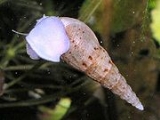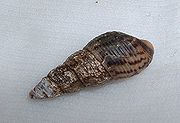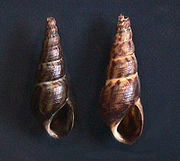
Malaysian Trumpet Snail
Encyclopedia
The red-rimmed melania, scientific name Melanoides tuberculata, is a species of freshwater snail
with an operculum
, a parthenogenetic
, aquatic
gastropod mollusk in the family Thiaridae
.
The common name
comes from the presence of reddish spots on the otherwise greenish-brown shell.
It is sometimes spelled Melanoides tuberculatus, but this is incorrect because Melanoides
Olivier, 1804 is feminine since it was combined with the feminine specific epithet fasciolata in the original desciption.

 This species has an elongate, conical shell, which is usually light brown, marked with rust-colored spots. An operculum
This species has an elongate, conical shell, which is usually light brown, marked with rust-colored spots. An operculum
is present.
The average shell length is about 20–27 mm or 30–36 mm, but exceptional specimens may be up to 80 mm long. Shells of this species have 10–15 whorls
.
and southern Asia
.
in Africa:
in Asia:
Prehistoric localities include Gobero
in Niger in 6200–5200 BCE.
This species can also be found in artificially-heated indoor habitats, such as aquaria
in greenhouse
s, and similar biotopes:
. These snails were imported to the United States by the aquarium trade as early as the 1930s. Established populations exist from Florida to Texas, and the species may still be expanding its range in the West and Northeast.
Some of these exotic populations have become very large, with densities of 10,000 per square metre being reported from the St. Johns River
in Florida
. In some cases red-rimmed melanias are believed to have a negative impact on native snail populations.
The nonindigenous distribution includes the United States: Arizona; San Francisco Bay, California; Colorado; Florida; Hawai'i; Louisiana; Montana; North Carolina; Nevada; Oregon; Utah; and Texas. (Unconfirmed in South Dakota, Virginia, and Wyoming.)
species that tends to be most active at night.
, and has been recorded in waters with a salinity
of 32.5 ppt
(1,024 specific gravity salinity).
It is however a warm-climate species. It appears to prefer a temperature range of 18 to 25°C or of 18 to 32°C. Research has been conducted to determine the snail's lethal high water temperature, which is about 50°C (120 degrees Fahrenheit). This information is helpful in the disinfection of fishing gear and research equipment, which otherwise may inadvertently spread the snails to uninfested waters.
This species is resistant to low oxygen levels.
and viviparity). Melanoides tuberculata has 1-64 embryos in its brood pouch. Snails will begin reproducing at a size as small as 5 mm or 10 mm in length and broods may contain over seventy offspring (iteroparity). The size of the shell of the parent at peak release of juveniles is 20.0 mm. The size of juveniles at birth is 1.2-2.2 mm.
Melanoides tuberculata grows to a similar size as Tarebia granifera
, are similar in size at first birth and juvenile output.
It is a r-strategist species.
This species is a host for a trematode parasite which has been found to infect an endangered species of fish in Texas, the fountain darter
.
plantations in Hong Kong
.
, but opinion in the hobby is divided between those who see them as a pest species, and those who value their usefulness as algae-eaters and substrate-cleaners. Among aquarists, these snails are known as Malayan livebearing snails or Malayan/Malaysian trumpet snails (often abbreviated to MTS).
interactions with Biomphalaria glabrata
:
Freshwater snail
A freshwater snail is one kind of freshwater mollusc, the other kind being freshwater clams and mussels, i.e. freshwater bivalves. Specifically a freshwater snail is a gastropod that lives in a watery non-marine habitat. The majority of freshwater gastropods have a shell, with very few exceptions....
with an operculum
Operculum (gastropod)
The operculum, meaning little lid, is a corneous or calcareous anatomical structure which exists in many groups of sea snails and freshwater snails, and also in a few groups of land snails...
, a parthenogenetic
Parthenogenesis
Parthenogenesis is a form of asexual reproduction found in females, where growth and development of embryos occur without fertilization by a male...
, aquatic
Aquatic animal
An aquatic animal is an animal, either vertebrate or invertebrate, which lives in water for most or all of its life. It may breathe air or extract its oxygen from that dissolved in water through specialised organs called gills, or directly through its skin. Natural environments and the animals that...
gastropod mollusk in the family Thiaridae
Thiaridae
Thiaridae, common name thiarids, is a family of tropical freshwater snails with an operculum, aquatic gastropod mollusks in the superfamily Cerithioidea....
.
The common name
Common name
A common name of a taxon or organism is a name in general use within a community; it is often contrasted with the scientific name for the same organism...
comes from the presence of reddish spots on the otherwise greenish-brown shell.
It is sometimes spelled Melanoides tuberculatus, but this is incorrect because Melanoides
Melanoides
Melanoides is a genus of freshwater snail with an operculum, an aquatic gastropod mollusk in the family Thiaridae.-Species:Species within the genus Melanoides include:* Melanoides admirabilis...
Olivier, 1804 is feminine since it was combined with the feminine specific epithet fasciolata in the original desciption.
Shell description


Operculum (gastropod)
The operculum, meaning little lid, is a corneous or calcareous anatomical structure which exists in many groups of sea snails and freshwater snails, and also in a few groups of land snails...
is present.
The average shell length is about 20–27 mm or 30–36 mm, but exceptional specimens may be up to 80 mm long. Shells of this species have 10–15 whorls
Whorl (mollusc)
A whorl is a single, complete 360° revolution or turn in the spiral growth of a mollusc shell. A spiral configuration of the shell is found in of numerous gastropods, but it is also found in shelled cephalopods including Nautilus, Spirula and the large extinct subclass of cephalopods known as the...
.
Distribution
This species is native to subtropical and tropical northern AfricaAfrica
Africa is the world's second largest and second most populous continent, after Asia. At about 30.2 million km² including adjacent islands, it covers 6% of the Earth's total surface area and 20.4% of the total land area...
and southern Asia
Asia
Asia is the world's largest and most populous continent, located primarily in the eastern and northern hemispheres. It covers 8.7% of the Earth's total surface area and with approximately 3.879 billion people, it hosts 60% of the world's current human population...
.
in Africa:
- Algeria, Burundi, The Democratic Republic of the Congo, Egypt, Eritrea, Ethiopia, Kenya, Libya, Malawi, Morocco, Mozambique, Namibia, Niger,
- South Africa (Eastern Cape Province, Free State, Gauteng, KwaZulu-Natal, Limpopo Province)
- Senegal, Sudan, Swaziland, Tanzania, Tunisia, Zimbabwe.
in Asia:
- Bangladesh, China, India (including Andaman Islands), Japan, Laos, Malaysia (Peninsular Malaysia), Nepal, Saudi Arabia, Sri Lanka, Vietnam
- Thailand
Prehistoric localities include Gobero
Gobero
The Gobero archaeological site was discovered in 2000 and is the oldest known graveyard in the Sahara Desert, dating back to 8000 BCE.Located in the Ténéré desert of Niger, it is named after the Tuareg name for the region.-Archaeology:...
in Niger in 6200–5200 BCE.
Nonindigenous distribution
- Cuba
- United States since 1930s (see below)
- Latin AmericaLatin AmericaLatin America is a region of the Americas where Romance languages – particularly Spanish and Portuguese, and variably French – are primarily spoken. Latin America has an area of approximately 21,069,500 km² , almost 3.9% of the Earth's surface or 14.1% of its land surface area...
in the late 1960s - Brazil - since 1967 (Ilha GrandeIlha GrandeIlha Grande is an island located off the coast of Rio de Janeiro state, Brazil, and part of the municipality of Angra dos Reis. The island is largely undeveloped and noted for its scenic beauty, which includes tropical beaches, luxuriant vegetation and a rugged landscape. The land area is...
in Rio de JaneiroRio de JaneiroRio de Janeiro , commonly referred to simply as Rio, is the capital city of the State of Rio de Janeiro, the second largest city of Brazil, and the third largest metropolitan area and agglomeration in South America, boasting approximately 6.3 million people within the city proper, making it the 6th...
in southeastern Brazil since 2004) - Netherlands - before 1990
- New Zealand
- Venezuela
- Dominica
- Trinidad
- and others
This species can also be found in artificially-heated indoor habitats, such as aquaria
Aquarium
An aquarium is a vivarium consisting of at least one transparent side in which water-dwelling plants or animals are kept. Fishkeepers use aquaria to keep fish, invertebrates, amphibians, marine mammals, turtles, and aquatic plants...
in greenhouse
Greenhouse
A greenhouse is a building in which plants are grown. These structures range in size from small sheds to very large buildings...
s, and similar biotopes:
- Czech Republic
- Germany
- Great Britain
- Slovakia - thermal brook in the wild.
- and others
Nonindigenous distribution in the United States
This species has become established outside of its natural range in large part through the activities of aquaristsFishkeeping
Fishkeeping is a popular hobby concerned with keeping fish in a home aquarium or garden pond. There is also a fishkeeping industry, as a branch of agriculture.-Types of fishkeeping systems:...
. These snails were imported to the United States by the aquarium trade as early as the 1930s. Established populations exist from Florida to Texas, and the species may still be expanding its range in the West and Northeast.
Some of these exotic populations have become very large, with densities of 10,000 per square metre being reported from the St. Johns River
St. Johns River
The St. Johns River is the longest river in the U.S. state of Florida and its most significant for commercial and recreational use. At long, it winds through or borders twelve counties, three of which are the state's largest. The drop in elevation from the headwaters to the mouth is less than ;...
in Florida
Florida
Florida is a state in the southeastern United States, located on the nation's Atlantic and Gulf coasts. It is bordered to the west by the Gulf of Mexico, to the north by Alabama and Georgia and to the east by the Atlantic Ocean. With a population of 18,801,310 as measured by the 2010 census, it...
. In some cases red-rimmed melanias are believed to have a negative impact on native snail populations.
The nonindigenous distribution includes the United States: Arizona; San Francisco Bay, California; Colorado; Florida; Hawai'i; Louisiana; Montana; North Carolina; Nevada; Oregon; Utah; and Texas. (Unconfirmed in South Dakota, Virginia, and Wyoming.)
Ecology
This is primarily a burrowingFossorial
A fossorial organism is one that is adapted to digging and life underground such as the badger, the naked mole rat, and the mole salamanders Ambystomatidae...
species that tends to be most active at night.
Habitat
Although normally a freshwater snail, this species is very tolerant of brackish waterBrackish water
Brackish water is water that has more salinity than fresh water, but not as much as seawater. It may result from mixing of seawater with fresh water, as in estuaries, or it may occur in brackish fossil aquifers. The word comes from the Middle Dutch root "brak," meaning "salty"...
, and has been recorded in waters with a salinity
Salinity
Salinity is the saltiness or dissolved salt content of a body of water. It is a general term used to describe the levels of different salts such as sodium chloride, magnesium and calcium sulfates, and bicarbonates...
of 32.5 ppt
Permille
A per mil or per mille is a tenth of a percent or one part per thousand. It is written with the sign ‰ , which looks like a percent sign with an extra zero at the end...
(1,024 specific gravity salinity).
It is however a warm-climate species. It appears to prefer a temperature range of 18 to 25°C or of 18 to 32°C. Research has been conducted to determine the snail's lethal high water temperature, which is about 50°C (120 degrees Fahrenheit). This information is helpful in the disinfection of fishing gear and research equipment, which otherwise may inadvertently spread the snails to uninfested waters.
This species is resistant to low oxygen levels.
Life cycle
Red-rimmed melania females are both parthenogenic and ovoviparous. Females can be recognized by their greenish coloured gonads while males have reddish gonads. Under good conditions, females will produce fertilised eggs that are transferred to a brood pouch where they remain until they hatch (parthenogenesisParthenogenesis
Parthenogenesis is a form of asexual reproduction found in females, where growth and development of embryos occur without fertilization by a male...
and viviparity). Melanoides tuberculata has 1-64 embryos in its brood pouch. Snails will begin reproducing at a size as small as 5 mm or 10 mm in length and broods may contain over seventy offspring (iteroparity). The size of the shell of the parent at peak release of juveniles is 20.0 mm. The size of juveniles at birth is 1.2-2.2 mm.
Melanoides tuberculata grows to a similar size as Tarebia granifera
Tarebia granifera
Tarebia granifera, common name in the aquarium industry the quilted melania, is a species of freshwater snail with an operculum, an aquatic gastropod mollusk in the family Thiaridae...
, are similar in size at first birth and juvenile output.
It is a r-strategist species.
Parasites
Melanoides tuberculata is known to carry certain parasites which can be dangerous to humans. Pinto & de Melo (2011) compiled checklist of 37 species of its trematode parasites. Eleven of those trematodes are also parasites of human. These snails serve as first intermediate host for parasites which include:- Clonorchis sinensisClonorchis sinensisClonorchis sinensis, the Chinese liver fluke, is a human liver fluke in the class Trematoda, Phylum Platyhelminthes. This parasite lives in the liver of humans, and is found mainly in the common bile duct and gall bladder, feeding on bile...
- Chinese liver fluke - Paragonimus westermaniParagonimus westermaniParagonimus westermani is a lung fluke and is most prominent in Asia and South America. It was discovered from two Bengal tigers that died in zoos in Europe in 1878...
- Oriental lung fluke - Metagonimus
- Diorchitrema formosanum
- Opisthorchis sinensis
- Philophthalmus sp.
- Haplorchis sp.
- Centrocestus formosanusCentrocestus formosanusCentrocestus formosanus is a trematode parasite of Asian origin that has found its way in to North American streams and rivers. It not only affects the fountain darter but many species of commercially important fishes....
- unknown species in SchistosomatidaeSchistosomatidaeSchistosomatidae is a family of digenetic trematodes with complex parasitic life cycles. Immature developmental stages of schistosomes are found in molluscs and adults occur in vertebrates. The best studied group, the blood flukes of the genus Schistosoma, infect and cause disease in humans...
This species is a host for a trematode parasite which has been found to infect an endangered species of fish in Texas, the fountain darter
Fountain darter
The fountain darter is a small freshwater fish found in the headwaters of only two rivers in Texas: the Comal River and the San Marcos River. It is generally smaller than 3 cm long and feeds on small invertebrates...
.
Agricultural pests
Red-rimmed melanias can sometimes be an agricultural pest species, as has been reported on Chinese cabbageChinese cabbage
Chinese cabbage can refer to two distinct varieties of Chinese leaf vegetables used often in Chinese cuisine. These vegetables are both related to the Western cabbage, and are of the same species as the common turnip...
plantations in Hong Kong
Hong Kong
Hong Kong is one of two Special Administrative Regions of the People's Republic of China , the other being Macau. A city-state situated on China's south coast and enclosed by the Pearl River Delta and South China Sea, it is renowned for its expansive skyline and deep natural harbour...
.
Aquaria
Red-rimmed melanias are quite commonly found in freshwater aquariaAquarium
An aquarium is a vivarium consisting of at least one transparent side in which water-dwelling plants or animals are kept. Fishkeepers use aquaria to keep fish, invertebrates, amphibians, marine mammals, turtles, and aquatic plants...
, but opinion in the hobby is divided between those who see them as a pest species, and those who value their usefulness as algae-eaters and substrate-cleaners. Among aquarists, these snails are known as Malayan livebearing snails or Malayan/Malaysian trumpet snails (often abbreviated to MTS).
Further reading
- Mitchella A. J. & Brandt T. M. (2005). "Temperature Tolerance of Red-Rim Melania Melanoides tuberculatus, an Exotic Aquatic Snail Established in the United States". Transactions of the American Fisheries Society 134(1): 126–131. doi:10.1577/FT03-178.1, abstract
- Bogéa T., Cordeiro F. M. & Gouveia J. S. (2005). "Melanoides tuberculatus (Gastropoda: Thiaridae) as intermediate host of Heterophyidae (Trematoda: Digenea) in Rio de Janeiro metropolitan area, Brazil". Revista do Instituto de Medicina Tropical de São Paulo 47(2): 87-90. . doi:10.1590/S0036-46652005000200005.
interactions with Biomphalaria glabrata
Biomphalaria glabrata
Biomphalaria glabrata is a species of air-breathing freshwater snail, an aquatic pulmonate gastropod mollusk in the family Planorbidae, the ram's horn snails....
:
- Pointier J. P. (1993). "The introduction of Melanoides tuberculata (Mollusca: Thiaridae) to the island of Saint Lucia (West Indies) and its role in the decline of Biomphalaria glabrata, the snail intermediate host of Schistosoma mansoni'. Acta Trop. 54:13-18.
- Giovanelli A., Vieira M. V. & da Silva C. L. P. A. C. (2002) "Interaction between the Intermediate Host of Schistosomiasis in Brazil Biomphalaria glabrata (Planorbidae) and a Possible Competitor Melanoides tuberculata (Thiaridae): I. Laboratory Experiments." Memórias do Instituto Oswaldo Cruz 97(3): 363-369. PDF
- Giovanelli A., Vieira M. V. & da Silva C. L. P. A. C. (2005) "Interaction Between The Intermediate Host Of Schistosomiasis In Brazil, Biomphalaria Glabrata (Say, 1818) And A Possible Competitor, Melanoides Tuberculata (Müller, 1774): A Field Study." Journal of Molluscan Studies 71(1): 7-13. doi:10.1093/mollus/eyi004, abstract

